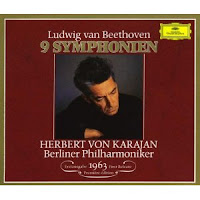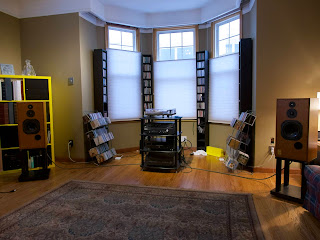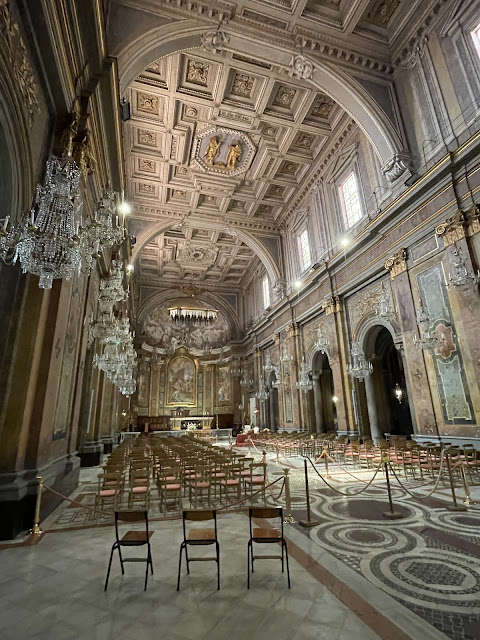Spring Cleaning: The Emotional Workout of Great Music
One of the things that drew me to classical music was the way it can serve up an emotional workout that leaves you with the same kind of satisfaction that a joyful bout of physical activity can. On the other hand, what I have found to be a bit difficult with a lot of popular music is how little emotional latitude it so often displays. My own life is one that will have many emotions in one day. This has become even more true in my years as a priest, where I may be celebrating a wedding and a funeral in the same day and still have to preach at the regular weekend Mass on Saturday evening. Good music helps to get me sorted out.
Just last night I sat down with the lights in my sitting room turned down, closed my eyes and unleashed the unbridled rendering of Beethoven's Fifth Symphony conducted by Herbert von Karajan with the Berlin Philharmonic. The majesty and power of the first movement gives way to an almost pastoral second movement, that nonetheless contains a very deep heart beat from the first. The third movement is jubilant.
 I don't know what your days are like, but I admit that sometimes I experience frustration. Inside I feel like the contesting point and counterpoint in the first movement. Like a good personal trainer, Beethoven takes me through the tightly wound feelings and gradually moves me to a relaxed and yet energized state.
I don't know what your days are like, but I admit that sometimes I experience frustration. Inside I feel like the contesting point and counterpoint in the first movement. Like a good personal trainer, Beethoven takes me through the tightly wound feelings and gradually moves me to a relaxed and yet energized state.
This kind of experience helps me to be open and I use it sometimes to move myself into a more focused state where I can pray and reflect more attentively. The music has pulled me apart and reorganized me so that those diverse emotions from the day become more articulate, more able to play a part in my spiritual conversations.
To land gently, I played a piece by Ravel. It has a rather jarring title: "Pavane pour une enfant defunte." Literally, a pavane for a deceased child. I find the peace quite beautiful. It has a reflective tone. Who knows maybe Ravel was appreciative of the gift of this child's life? The way that the various instruments play almost in unison while lending different colours in the piece is intriguing. The long "breaths" in the piece also slow you down nicely.
 I am going to the symphony orchestra here in Toronto this week for the first of two concerts that I am attending in the next two weeks. Both will feature Rachmaninov, one of my favourite composers. His piano concertos have the same kind of effect on me. This week I will be listening to the spicy Gabriela Monteiro play. I am really looking forward to it! I am also looking forward to hearing Messiaen's "Les Offrandes Oublies", which he wrote after World War II. Expect a report.
I am going to the symphony orchestra here in Toronto this week for the first of two concerts that I am attending in the next two weeks. Both will feature Rachmaninov, one of my favourite composers. His piano concertos have the same kind of effect on me. This week I will be listening to the spicy Gabriela Monteiro play. I am really looking forward to it! I am also looking forward to hearing Messiaen's "Les Offrandes Oublies", which he wrote after World War II. Expect a report.
On the technical side I have an old "quadrophonic" recording with the Minnesota Orchestra and Stanislaw Skrowaczewski which has been reissued as a hybrid SACD (Super Audio CD). On a 5.1 system the original discrete four channels are reproduced. I play it on a stereo SACD player (two channels) and it sounds really nice to me. SACD's are considerably denser than CD's. Unless the disc is listed as hybrid, an SACD requires a playback machine with this Sony, proprietary technology. There are many recordings of this piece of music.
Just last night I sat down with the lights in my sitting room turned down, closed my eyes and unleashed the unbridled rendering of Beethoven's Fifth Symphony conducted by Herbert von Karajan with the Berlin Philharmonic. The majesty and power of the first movement gives way to an almost pastoral second movement, that nonetheless contains a very deep heart beat from the first. The third movement is jubilant.
 I don't know what your days are like, but I admit that sometimes I experience frustration. Inside I feel like the contesting point and counterpoint in the first movement. Like a good personal trainer, Beethoven takes me through the tightly wound feelings and gradually moves me to a relaxed and yet energized state.
I don't know what your days are like, but I admit that sometimes I experience frustration. Inside I feel like the contesting point and counterpoint in the first movement. Like a good personal trainer, Beethoven takes me through the tightly wound feelings and gradually moves me to a relaxed and yet energized state. This kind of experience helps me to be open and I use it sometimes to move myself into a more focused state where I can pray and reflect more attentively. The music has pulled me apart and reorganized me so that those diverse emotions from the day become more articulate, more able to play a part in my spiritual conversations.
To land gently, I played a piece by Ravel. It has a rather jarring title: "Pavane pour une enfant defunte." Literally, a pavane for a deceased child. I find the peace quite beautiful. It has a reflective tone. Who knows maybe Ravel was appreciative of the gift of this child's life? The way that the various instruments play almost in unison while lending different colours in the piece is intriguing. The long "breaths" in the piece also slow you down nicely.
 I am going to the symphony orchestra here in Toronto this week for the first of two concerts that I am attending in the next two weeks. Both will feature Rachmaninov, one of my favourite composers. His piano concertos have the same kind of effect on me. This week I will be listening to the spicy Gabriela Monteiro play. I am really looking forward to it! I am also looking forward to hearing Messiaen's "Les Offrandes Oublies", which he wrote after World War II. Expect a report.
I am going to the symphony orchestra here in Toronto this week for the first of two concerts that I am attending in the next two weeks. Both will feature Rachmaninov, one of my favourite composers. His piano concertos have the same kind of effect on me. This week I will be listening to the spicy Gabriela Monteiro play. I am really looking forward to it! I am also looking forward to hearing Messiaen's "Les Offrandes Oublies", which he wrote after World War II. Expect a report. On the technical side I have an old "quadrophonic" recording with the Minnesota Orchestra and Stanislaw Skrowaczewski which has been reissued as a hybrid SACD (Super Audio CD). On a 5.1 system the original discrete four channels are reproduced. I play it on a stereo SACD player (two channels) and it sounds really nice to me. SACD's are considerably denser than CD's. Unless the disc is listed as hybrid, an SACD requires a playback machine with this Sony, proprietary technology. There are many recordings of this piece of music.

